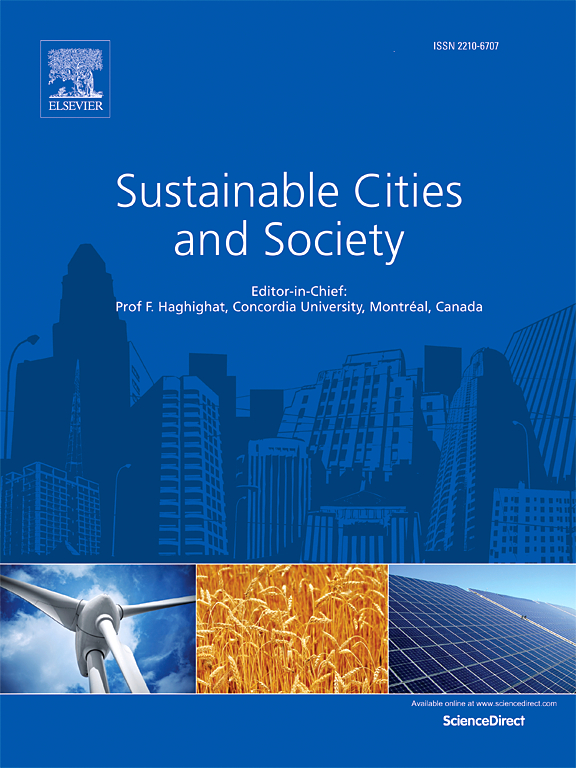Experimental and computational predictions of odorant transport dynamics from indoor environment to olfactory tissue
IF 10.5
1区 工程技术
Q1 CONSTRUCTION & BUILDING TECHNOLOGY
引用次数: 0
Abstract
The intricate dynamics of odorants in the indoor environment and human respiratory system remain poorly understood. In the present study, we integrate odor sensory tests (OSTs) and computational fluid dynamics coupled with a physiologically based pharmacokinetic (CFD-PBPK) model to elucidate various aspects of odorant transport and olfaction dynamics. Safe yogurt-derived substances were incorporated into OSTs to prevent harmful exposure. Acetaldehyde was identified as a key active component in determining odor intensity, prompting further analysis of acetone and other four constituents. Logarithmic correlations were established between the perceived odor intensity from the OSTs and both time-averaged absorption flux and equilibrium concentration within the olfactory mucus layer. These parameters were numerically captured, enabling the logarithmic approximation of odor intensity for different breathing profiles and developing reliable prediction models for odor sensation in the indoor environment based on quantifiable physiological parameters. Location-specific analysis revealed the nostrils and olfactory regions as the most accurate indicators of perceived odor intensity, proving the limitations of rough sensory assessments in the indoor/breathing zone scales. This study offers insights for potential safe and sustainable applications, such as smart odor displays, e-noses, and sensors/control systems in the indoor environment, particularly for long-term exposure in industries that emit harmful compounds.
气味从室内环境到嗅觉组织的传输动力学的实验和计算预测
气味剂在室内环境和人体呼吸系统中的复杂动力学仍然知之甚少。在本研究中,我们将气味感觉测试(OSTs)和计算流体动力学与基于生理的药代动力学(CFD-PBPK)模型相结合,以阐明气味运输和嗅觉动力学的各个方面。安全的酸奶衍生物质被纳入ost,以防止有害的接触。乙醛被确定为决定气味强度的关键活性成分,促使进一步分析丙酮和其他四种成分。在OSTs感知到的气味强度与嗅觉黏液层内的时间平均吸收通量和平衡浓度之间建立了对数相关关系。通过对这些参数进行数值捕获,可以对不同呼吸特征的气味强度进行对数逼近,并基于可量化的生理参数开发可靠的室内环境气味感觉预测模型。特定位置的分析显示,鼻孔和嗅觉区域是感知气味强度的最准确指标,证明了室内/呼吸区尺度中粗略的感官评估的局限性。这项研究为潜在的安全和可持续应用提供了见解,例如室内环境中的智能气味显示,电子鼻和传感器/控制系统,特别是在排放有害化合物的行业中长期暴露。
本文章由计算机程序翻译,如有差异,请以英文原文为准。
求助全文
约1分钟内获得全文
求助全文
来源期刊

Sustainable Cities and Society
Social Sciences-Geography, Planning and Development
CiteScore
22.00
自引率
13.70%
发文量
810
审稿时长
27 days
期刊介绍:
Sustainable Cities and Society (SCS) is an international journal that focuses on fundamental and applied research to promote environmentally sustainable and socially resilient cities. The journal welcomes cross-cutting, multi-disciplinary research in various areas, including:
1. Smart cities and resilient environments;
2. Alternative/clean energy sources, energy distribution, distributed energy generation, and energy demand reduction/management;
3. Monitoring and improving air quality in built environment and cities (e.g., healthy built environment and air quality management);
4. Energy efficient, low/zero carbon, and green buildings/communities;
5. Climate change mitigation and adaptation in urban environments;
6. Green infrastructure and BMPs;
7. Environmental Footprint accounting and management;
8. Urban agriculture and forestry;
9. ICT, smart grid and intelligent infrastructure;
10. Urban design/planning, regulations, legislation, certification, economics, and policy;
11. Social aspects, impacts and resiliency of cities;
12. Behavior monitoring, analysis and change within urban communities;
13. Health monitoring and improvement;
14. Nexus issues related to sustainable cities and societies;
15. Smart city governance;
16. Decision Support Systems for trade-off and uncertainty analysis for improved management of cities and society;
17. Big data, machine learning, and artificial intelligence applications and case studies;
18. Critical infrastructure protection, including security, privacy, forensics, and reliability issues of cyber-physical systems.
19. Water footprint reduction and urban water distribution, harvesting, treatment, reuse and management;
20. Waste reduction and recycling;
21. Wastewater collection, treatment and recycling;
22. Smart, clean and healthy transportation systems and infrastructure;
 求助内容:
求助内容: 应助结果提醒方式:
应助结果提醒方式:


